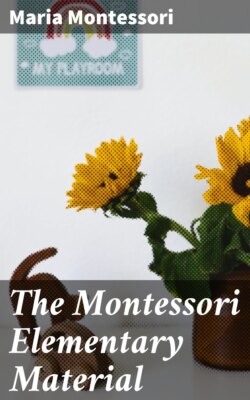| | FACING PAGE |
| The first Montessori Elementary Class in America | Frontispiece |
| One of the first steps in grammar | 24 |
| Grammar Boxes, showing respectively two and three parts of speech | 25 |
| Grammar Boxes, showing respectively four and five parts of speech | 78 |
| Grammar Boxes, showing respectively six and seven parts of speech | 79 |
| Grammar Boxes, showing respectively eight and nine parts of speech | 114 |
| The children working at their various occupations in complete freedom | 115 |
| Interpreted reading: "Smile and clap your hands" | 174 |
| Interpreted reading: "Take off your hat and make a low bow" | 175 |
| Interpreted reading: "Whisper to him" | 188 |
| Interpreting the pose and expression of a picture | 189 |
| Interpreted reading: "She was sleepy; she leaned her arms on the table, her head on her arms, and went to sleep" | 200 |
| Exercises in interpreted reading and in arithmetic | 201 |
| The bead material used for addition and subtraction | 214 |
| Counting and calculating by means of the bead chains | 214 |
| The bead chain, square, and cube | 215 |
| The first bead frame | 215 |
| The second counting-frame used in arithmetic | 226 |
| Working out problems in seven figures | 227 |
| Solving a problem in long division | 238 |
| Bead squares and cubes; and the arithmetic-board for multiplication and division | 239 |
| The bead number cubes built into a tower | 282 |
| The decagon and the rectangle composed of the same triangular insets | 283 |
| The triangular insets fitted into their metal plates | 283 |
| Showing that the two rhomboids are equal to the two rectangles | 288 |
| Showing that the two rhomboids are equal to the two squares | 289 |
| Hollow geometric solids | 296 |
| Designs formed by arranging sections of the insets within the frames | 297 |
| Making decorative designs with the aid of geometric insets | 312 |
| Water-color paintings from nature | 313 |
| The monocord | 334 |
| Material for indicating the intervals of the major scale | 334 |
| The music bars | 335 |
| The children using the music bells and the wooden keyboards | 352 |
| Analyzing the beat of a measure while walking on a line | 353 |
